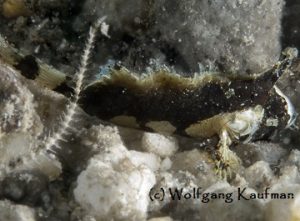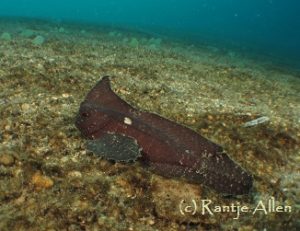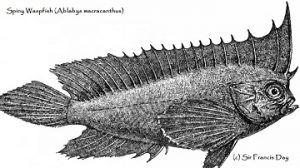Loading content - please wait...
Acanthosphex leurynnis Discovered in Gorontalo
Acanthosphex leurynnis, a rarely seen type of waspfish, recently made an appearance in Gorontalo.
Surprising Find: Acanthosphex leurynnis

During a great muck dive in February 2018, one of our guests discovered an unusual fish. Initially, Miguel’s Diving staff assumed it was a juvenile Cockatoo waspfish, which is often seen at the Tambo’o Fish House Dive Site. That muck site continues to thrill divers with its variety and density of marine critters.
Fortunately, Wolfgang from Germany took a photo of the fish. Then staff sent the photo to a marine identification community on Facebook. A longtime marine biologist working in Pacific Asia identified the fish for us. It turned out to be a Wasp-spine velvetfish. Its scientific name is Acanthosphex leurynnis. It is the only species in its genus. This fish is so seldom seen that it is missing from even large volume fish books. The Smithsonian Museum of Natural History possesses specimens of Acanthosphex leurynnis from Thailand, Malaysia, the Philippines, Japan and Australia.
The Wasp-spine velvetfish grows to a maximum of nine centimeters. Its coloration tends to be dark to light mottled brown. Additionally, white patches occur randomly on its body. It has two spines pointing behind its eye and four more behind its chin. Also, the chin has a pair of short tentacles. Given its small size and camouflaged coloration, divers rarely see this singular fish.
Waspfish of the World
Although Acanthosphex leurynnis is not technically a waspfish, it is generally grouped with waspfish species. Worldwide, there are forty species of waspfish. However, because they are secretive and nocturnal, divers rarely seen them. Some waspfish have venomous spines that can cause painful stings. Waspfish eat shrimps and other small invertebrates. Typically
, the tall dorsal fin on the head is the distinguishing characteristic of waspfish.
Waspfish in Gorontalo

Besides the unusual sighting of Acanthosphex leurynnis, divers in Gorontalo are most likely to see Cockatoo waspfish (Ablabys taenianotus). This fish has great camouflage and looks like a dead, brown leaf laying in the sand. They are often in pairs. So, careful divers will look for another one if one is already found. Although this waspfish tends to be dull brown, it can have white on its face.
In Gorontalo, divers will only see waspfish at a single dive site, Tambo’o Fish House. A careful diver will check each dead leaf lying on the sand. If spotted, a waspfish will pretend that a slight current is pushing it about and moving it away. The motions are quite clever!
It lives in the western Pacific Ocean, including northern Australia and Japan. Despite what some guidebooks or interet postings claim, it does not live in the Indian Ocean. The waspfish that lives there is a different species, Ablabys binotatus.

Actually, another waspfish lives only in Indonesia and the Philippines. It is the Spiny waspfish (Ablabys macrancanthus). Distinguishing it in the ocean from the Cockatoo waspfish is extremely difficult. According to marine biologists, the spines of the Ablabys macrancanthus protrude from its dorsal fin. Hence its common name Spiny. The guaranteed way to distinguish between the two species is to count dorsal spines. The less common Spiny waspfish has 15 to 16 and the more widespread Cockatoo waspfish has 17 to 18.
Few divers will wish to count waspfish spines! However, for your chance to see a waspfish in Gorontalo






Sorry, comments are closed for this post.